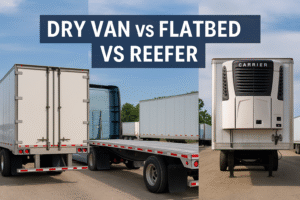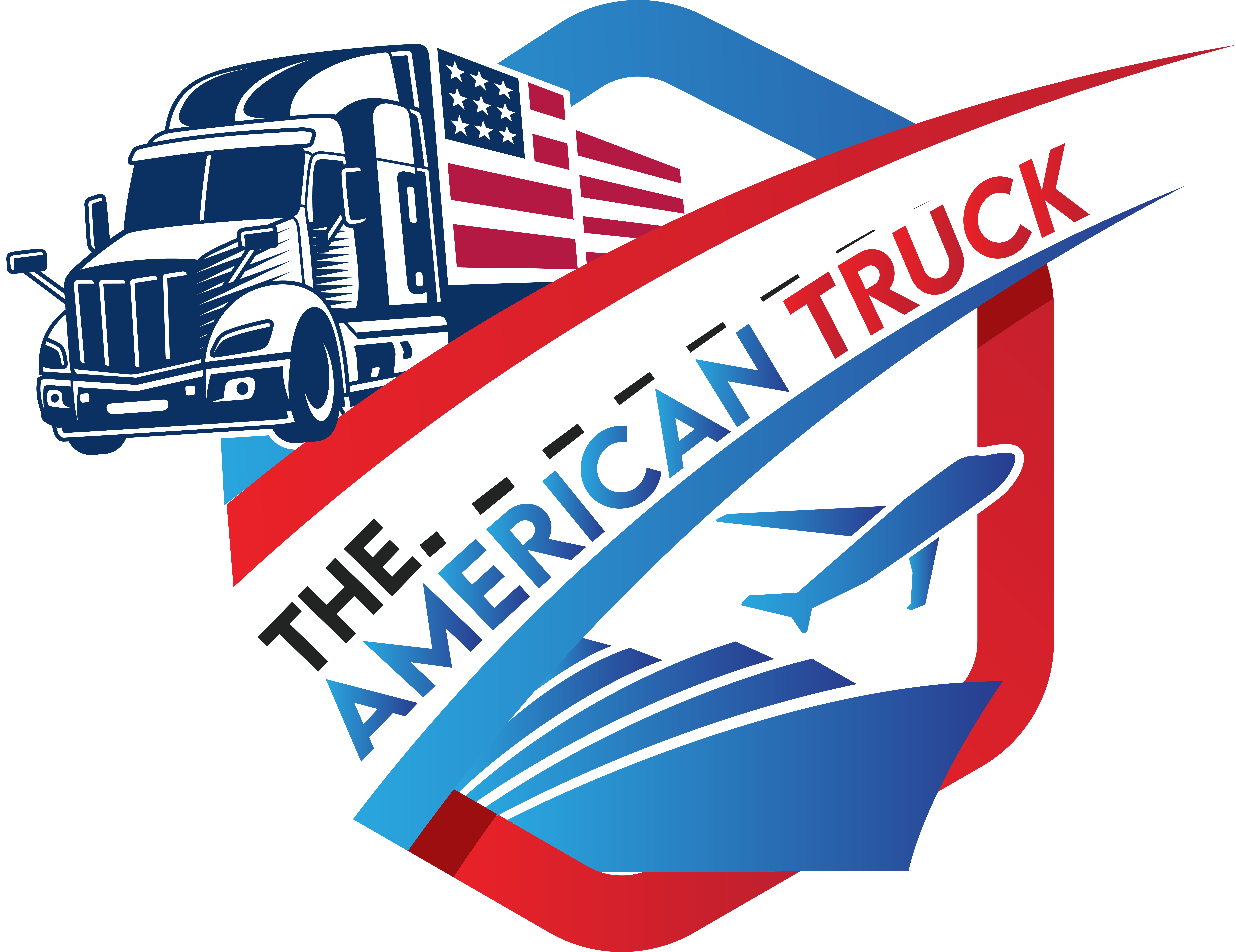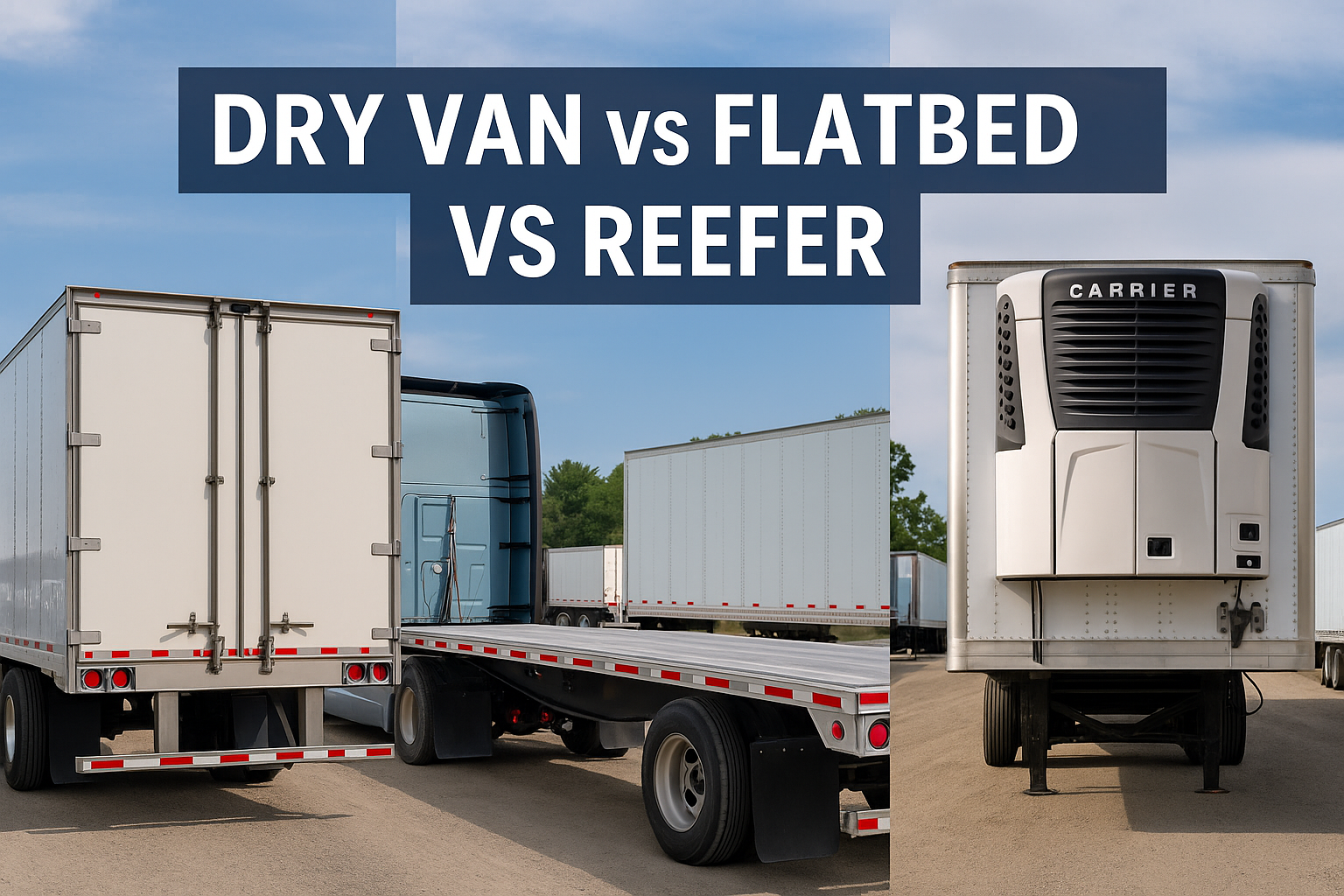
Choosing the wrong trailer is like showing up to a construction site in flip-flops. Not wise, and definitely not safe.
If you’ve ever looked at a freight quote and thought, “What exactly is a reefer?” (nope, not that one), or figured flatbed sounds simpler — you’re in the right spot.
Let’s cut to the chase and figure out which one suits your freight.
There’s no one-size-fits-all in freight. That’s why we’ve got:
- Dry Van – The workhorse.
- Flatbed – The muscle.
- Reefer – The cool operator.
Pick the right one for your load, and you save time, money, and headaches.
Dry Van: Everyday Hero
You’ve seen them everywhere. Closed in, secure, and perfect for standard shipping.
Best For:
- Packaged goods
- Retail products
- Electronics
- Food that doesn’t need refrigeration
Pros:
- Weather and theft protection
- Low cost
- Widely available
Cons:
- No temperature control
- Rear-only loading
- Not ideal for oversized or awkward cargo
Think of it like a standard sedan — simple, reliable, gets the job done.
But here’s a kicker. Dry vans are not always the cheapest when shipping lightweight but bulky cargo. You’re paying for volume, not just weight. In some cases, LTL shipping in a reefer or even a smaller flatbed section can save you costs. Don’t assume. Confirm.
Also, double-stacked pallets? Most dry vans don’t support that safely. You could end up with crushed goods if your packaging isn’t solid.
Flatbed: Heavy Haul Champion
No walls, no roof — just a solid platform.
Best For:
- Machinery
- Steel beams
- Lumber or pipes
- Vehicles
Pros:
- Easy loading from sides or top
- Handles large or oddly-shaped cargo
- Doesn’t require a dock
Cons:
- Exposed to weather
- Requires more effort to secure cargo
- Takes longer to load
Flatbeds are often your only option for shipments that are classified as over-dimensional or over-weight. That means extra permits, escorts, and route planning. But it also means flexibility. If you can secure it and balance the weight, you can likely move it.
One thing to keep in mind? Tarps. You might assume tarps are standard. They’re not. Some carriers charge extra. Some don’t even tarp. Make sure that’s discussed upfront.
Flatbeds also need experienced drivers. The tie-down process isn’t just about strength — it’s about technique. The American Truck Inc, for example, has dedicated teams trained specifically for flatbed operations. That means better load safety and fewer insurance claims.
No, not that reefer. This one keeps things cold.
Best For:
- Frozen food
- Fresh produce
- Medicine
- Cosmetics
Pros:
- Maintains temperature
- Prevents spoilage
- Some models control humidity too
Cons:
- Higher cost
- Needs constant fuel or power
- Needs ongoing monitoring
Reefers aren’t just about cold. Some are also used to keep products warm in freezing weather. Pharmaceuticals, certain paints, even batteries can all be ruined by cold just as much as by heat.
And let’s not forget the compliance side. With FSMA (Food Safety Modernization Act) in the U.S., you’re legally required to ensure temperature tracking and record-keeping for food and medical shipments. Make sure your carrier provides temperature logs or live data access.
Side-by-Side Comparison: Dry Van vs Flatbed vs Reefer
| Feature | Dry Van | Flatbed | Reefer |
|---|---|---|---|
| Weather Protection | Yes | No | Yes |
| Loading Access | Rear-only | All sides/top | Rear-only |
| Temp Control | No | No | Yes |
| Cost | Low | Medium | High |
| Common Cargo | Retail goods | Machinery, steel | Food, medicine |
| Specialized Permits | Rare | Often needed | Sometimes |
| Monitoring Required | No | Visual only | Yes |
Best Trailer for Different Situations
Shipping washing machines? Dry van is your buddy.
Moving a bulldozer from Texas to Ohio? Go with a flatbed.
Fresh berries in July? Reefer or bust.
Got a mix of sensitive electronics and cardboard boxes? You might need to split the load.
Real Case: How Flatbed Saved Thousands
Our partner, The American Truck Inc, had to move an industrial HVAC system. It was huge, heavy, and awkward. No way it would fit in a dry van.
They chose flatbeds, used cranes to load from the side, and calculated wind pressure for proper tie-downs.
Result? Shipment arrived safely, on time, and intact. One bad decision could’ve ruined everything.
This wasn’t just a shipment — it was their reputation.
(See more at The American Truck Inc)
Questions to Ask Before You Choose:
- Is your cargo sensitive to temperature?
- Can it be exposed to weather?
- Is the shape or size unusual?
- How will it be loaded — dock or crane?
- How far is it going?
- Are there compliance requirements for tracking or reporting?
- Is your shipment LTL or FTL?
Mixed Loading? It’s Possible
Sometimes, combining trailers is the smart move.
Start with a reefer, switch to a dry van later — if only part of the trip needs cooling.
Others mix flatbeds and dry vans within the same route when cargo types differ.
Hybrid logistics is growing. Think of it as building your own trailer strategy, not settling for someone else’s.
Mistakes to Avoid
- Sending perishable items on a flatbed
- Forgetting height limits and hitting overpasses
- Thinking dry vans protect from humidity (they don’t)
- Assuming all reefers are calibrated correctly
- Using the wrong type of tie-down for flatbed freight
Shipping Planning Tips
- Confirm trailer dimensions with your carrier.
- Avoid last-minute trailer switches.
- Know the loading conditions at pickup and delivery.
- Ask for photos of previous loads (especially with specialty carriers).
- Get temperature logs if shipping perishables.
- Read the insurance terms — most carriers don’t cover your full cargo value by default.
Good planning = safe delivery.
SEO Notes
Searching for Best Trailer Freight? This guide covers it.
Heavy Haul Trailer? That’s your flatbed.
Temperature Controlled Freight? Say hello to the reefer.
Dry Van vs Flatbed vs Reefer — now you know what fits.
Final Thoughts:
Picking the right trailer depends on your cargo, route, budget, and risk tolerance.
Dry vans are great for general items. Flatbeds handle the oversized and heavy. Reefers protect the perishable.
Don’t just look for availability. Look for compatibility.
Talk to your carrier. Ask smart questions. Or partner with someone who already has the answers.
Need help? The American Truck Inc has years of experience pairing the right trailer with the right job.

